Abdominal ventral rectopexy with colectomy for obstructed defecation syndrome: An alternative option for selected patients
2020-04-07LiWangChunXueLiYueTianJingWangYeFanLiWeiDongTong
Li Wang, Chun-Xue Li, Yue Tian, Jing-Wang Ye, Fan Li, Wei-Dong Tong
Li Wang, Chun-Xue Li, Yue Tian, Jing-Wang Ye, Fan Li, Wei-Dong Tong, Department of General Surgery, Daping Hospital, Army Medical University, Chongqing 400042, China
Abstract BACKGROUND Abdominal ventral rectopexy (AVR) with colectomy is controversial in the treatment of obstructed defecation syndrome (ODS). Literature data on this technique for ODS are very limited.AIM To evaluate the safety and efficacy of AVR with colectomy for selected patients with ODS.METHODS Consecutive patients who underwent AVR with colectomy for ODS were identified prospectively from 2016 to 2017 in our department. Patient demographics, perioperative surgical results, and postoperative follow-up outcomes were collected and analyzed. Long-term follow-up was evaluated with standardized questionnaires. The severity of symptoms was assessed by the objective Wexner Constipation Score (WCS) and ODS Score. The quality of life was assessed by the Patients Assessment of Constipation Quality of Life score.Functional outcome was compared pre- and post-operatively for each patient. The primary outcomes were determined by the improvement in symptoms and quality of life. Secondary outcome measures were operating time, postoperative length of stay, morbidity and mortality, improvement of pelvic floor structure,and patient satisfaction.RESULTS Four patients underwent robotic-assisted surgery, and two patients underwent a laparoscopic-assisted procedure. The mean operating time for the robotic approach was 243 min (range 160–300 min), and the mean operating time for the laparoscopic approach was 230 min (range 220-240 min). The mean postoperative length of stay was 8.2 d (range 6-12 d). There was no conversion to open procedure and no postoperative mortality. No urinary retention, wound infection,prolonged ileus, pelvic infection and anastomosis leakage occurred. Six patients were followed up for 36 mo. The WCS, ODS, and Patients Assessment of Constipation Quality of Life score improved significantly postoperatively (P <0.05). The WCS and ODS scores showed the best remission and stabilization at 6 to 12 mo after surgery. There was no recurrence or novel constipation after surgery. None of the patients used laxative medication.CONCLUSION Robotic and laparoscopic-assisted ventral rectopexy with colectomy is a safe and effective procedure for selected patients with ODS. However, comprehensive preoperative evaluation and careful patient selection are essential.
Key Words: Obstructed defecation syndrome; Ventral mesh rectopexy; Colectomy; Internal rectal prolapse; Constipation; Laparoscopic resection rectopexy
INTRODUCTION
Obstructed defecation syndrome (ODS) is the most common type of chronic constipation. It comprises a wide spectrum of defecation disorders, mainly including incomplete evacuation, defecation straining, digital assistance, and repetitive toilet visits[1]. ODS is mainly caused by pelvic floor structural abnormalities, such as rectal prolapse, rectal intussusception, and rectocele[2]. The common clinical symptom of internal rectal prolapse (IRP) is ODS, while the patient with external rectal prolapse(ERP) usually complains of prolapse of an anal mass, obstructed defecation (OD), and fecal incontinence (FI)[3,4]. Patients with ODS often depend on a laxative and/or enema,and they have accompanying psychological disorders. Their quality of life is severely impaired when medication becomes less effective over time. Unlike ERP, which always requires surgery, the indication for surgery in IRP arises from severe symptoms of chronic constipation with failure of conservative treatment and a subjective reduction in quality of life, and does not depend on the finding of abnormal morphology alone. In these patients who may benefit from surgical therapy, this not only depends on imaging findings but more importantly relies on the patient’s feeling.
Many different surgical procedures have been developed to treat patients with ODS,which mainly include transperineal and transabdominal approaches, and no optimal procedure has been identified for all patients to date[2,3,5-7]. Perineal surgery is usually used in elderly frail patients who are unfit for a general anesthetic, but it has a higher risk of recurrence[8]. In recent years, abdominal surgery has become a common practice in the treatment of ODS with the development of mini-invasive techniques, especially for patients with accompanying pelvic floor dysfunction[6,7,9-14]. Laparoscopic surgery is routinely performed, and the use of robotic assistance is progressively increasing in pelvic floor surgery due to its technical advantage in a narrow confined space[15-17].However, technically, there are ongoing debates on the transabdominal approach that can be categorized into with or without resection of the colon, and with or without implantation of mesh. After the technique of laparoscopic ventral rectopexy (LVR) was first described by D’Hooreet al[18], the procedure became a novel method adopted rapidly all over the world, which is a safe solution for relieving intussusception- and prolapse-related symptoms, including OD and FI, with a lower morbidity rate[19]. It is currently considered to be the standard procedure for full-thickness ERP in Europe[6,20].
Laparoscopic resection rectopexy (LRR) is also a safe and effective procedure achieving good long-term results with an improvement in ODS symptoms and an acceptable morbidity[21]. Abdominal posterior rectopexy with sigmoid resection has shown satisfactory functional improvements in patients with prolapse and preoperative constipation[22]. A systematic review by Emileet al[13]showed that resection rectopexy for IRP had a lower recurrence rate, whereas ventral rectopexy achieved better symptomatic improvement, a shorter operative time and a lower complication rate. Therefore, rectopexy with or without resection is controversial, and there have been few reports on resection rectopexy in recent years[20,23,24].
It has not been reported whether abdominal ventral rectopexy (AVR) combined with an extended colon resection provides better functional results in the treatment of ODS, and this is worthy of exploration. Therefore, we report our preliminary experience of AVR with an extended colectomy to evaluate its safety and efficacy in selected patients with ODS.
MATERIALS AND METHODS
Study design
Consecutive patients who received AVR with colectomy for ODS between January 2016 and December 2017 in our department were identified prospectively. Data regarding patient demographics, perioperative surgical results and postoperative follow-up outcomes were obtained prospectively. The study was performed according to the approval of the Medical Ethics Committee of Daping Hospital. Written informed consent was obtained from all participants.
Inclusion and exclusion criteria
Patients with ODS who conformed to the Rome III criteria of functional constipation and who failed maximal conservative treatments including biofeedback and medical therapy were eligible for the study. A precise patient history, diagnostic workup,including physical examination, colonoscopy, anorectal manometry, defecography,barium enema, pelvic dynamic magnetic resonance imaging, and colonic transit test,was examined preoperatively. Patients with severe constipation symptoms [Wexner Constipation Score (WCS) > 15 and ODS score > 10], grade III-IV full-thickness rectal intussusception, along with pelvic floor anatomic abnormalities, such as abnormally deep cul-de-sac, descending perineum syndrome, rectocele, enterocele, retroversion of the uterus, and redundant colon, were recruited into the study. The grade of rectal prolapse was according to the Oxford radiological prolapse grading system[25,26].
Exclusion criteria were previous anal surgery or colorectal resection, malignancy,inflammatory bowel disease, megacolon, ERP, pregnancy, as well as contraindications for general anesthesia. Patient characteristics are summarized in Table 1.
Surgical procedure
The operation was performedviarobotic or laparoscopic-assisted surgery. The left colon was mobilized completely with release of the splenic flexure, and protection of the superior rectal artery and the hypogastric nerves at the same time. The anterior plane of the rectum was dissected from the vagina downwards to the levator ani muscle. The colonic mesentery was dissociated close to the colon wall of the rectal sigmoid junction, and the colon was transected using an Endoscopic Cutting stapler.The proximal colon was pulled outviaan enlarged trocar incision in the left lower quadrant, and the sigmoid colon and descending colon (50-60 cm) were resected. The anastomosis was achieved with a laparoscopic double-staple technique. Then, pelvic and surgical field irrigation was performed to avoid potential contamination. The ventral mesh rectopexy (VMR) technique was primarily performed by following the details described by D’Hooreet al[18]. A strip of 3 cm × 17 cm tailored rectangular mesh was positioned at the lowest point of the rectovaginal space. Fixation between the anterior wall of the distal rectum and mesh was sutured with 2-0 PDS. The proximal end of the mesh was sutured on the sacral promontory after the rectum was pulled upwards. Finally, the right lateral peritoneal incision was closed to cover the mesh andthe pelvic floor peritoneum was reconstructed with a running suture with 2-0 Prolene to obliterate the cul-de-sac. The uterus was fixed to the anterior position by a suture of round ligaments. The operative technique was similar in the robotic and laparoscopic surgeries. The excised specimens were sent for pathological examination. All operations were performed by the same surgical team to ensure quality control(Figure 1).
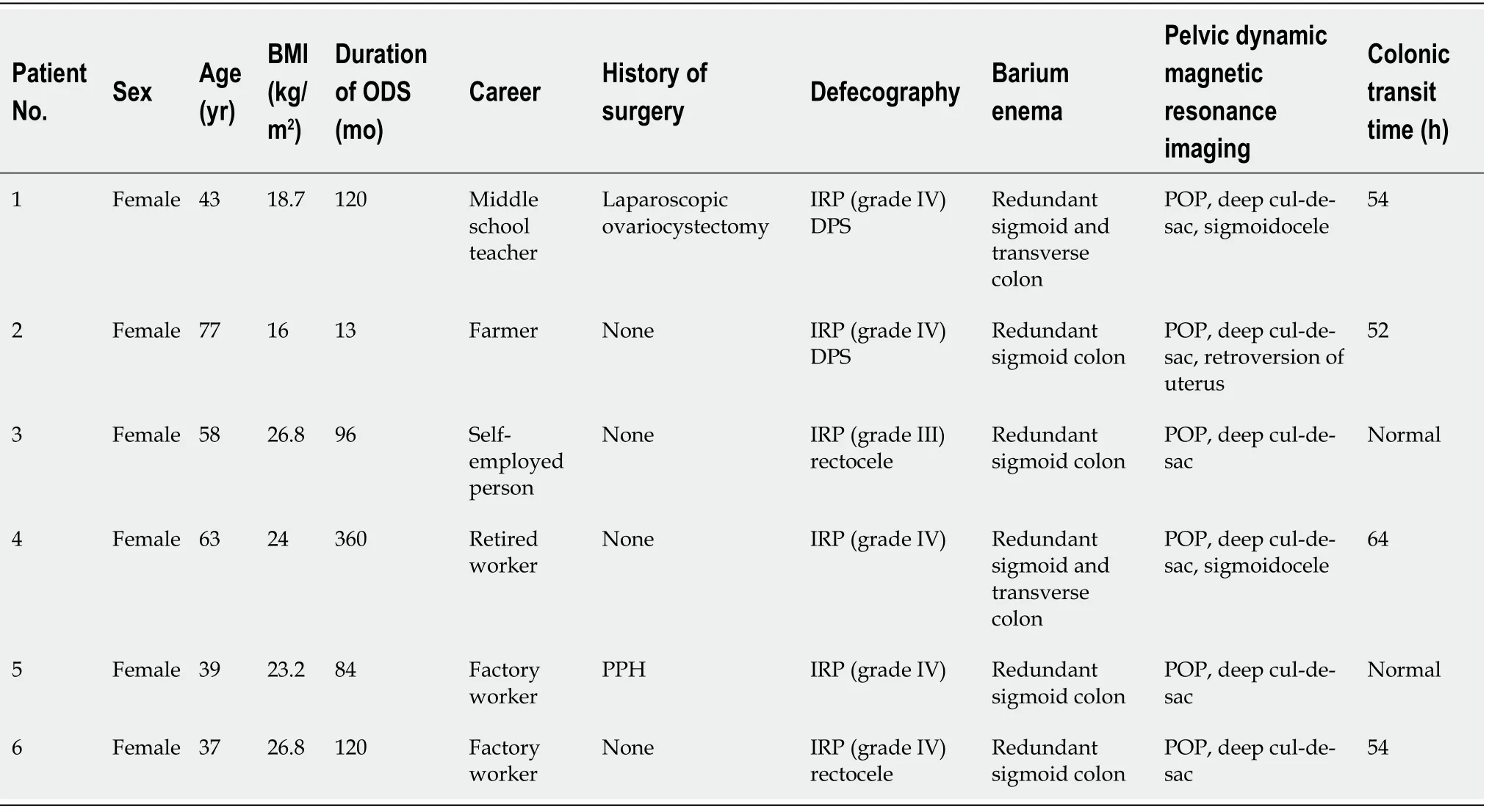
Table 1 Patient characteristics
Postoperative follow-up and outcomes
Postoperative evaluation, including improvement in symptoms, quality of life, patient satisfaction, intake of laxative medication, and recurrence was performed. Patients were followed up at 3, 6, 12, 24, and 36 mo after surgery. Long-term follow-up was evaluated with standardized questionnaires in the outpatient clinic. The severity of symptoms was assessed by the objective WCS and ODS score. Quality of life was assessed by the Patients Assessment of Constipation Quality of Life score. The functional result was compared pre- and post-operatively for each patient. Recurrence was defined as symptoms of persistent obstructed defecation or new symptoms with an ODS score > 10 or WCS > 15, or an anatomic rectal prolapse (Oxford grade ≥ 2)diagnosed by defecography or dynamic magnetic resonance imaging.
The primary outcomes were determined by the improvement in symptoms and quality of life. Secondary outcome measures were operating time, postoperative length of stay, complications and mortality, improvement of pelvic floor structure, and patient satisfaction.
Statistical analysis
Statistical analyses were performed using SPSS 24.0 (SPSS, Chicago, IL, United States).The Mann–WhitneyUtest was used to compare the preoperative scores with the follow-up scores. APvalue < 0.05 was considered statistically significant.
RESULTS
Patient characteristics

Figure 1 Abdominal ventral rectopexy with colectomy for obstructed defecation syndrome. A: The anterior plane of the rectum was dissected from the vagina down to the levator ani; B: Colorectal anastomosis; C: The distal mesh fixation was performed at the lowest point of the rectovaginal space; D: The proximal mesh was sutured on the sacral promontory.
Six patients underwent robotic-assisted and laparoscopic-assisted VMR with colectomy. All patients were female with a mean age of 53 years (range 37-77 years).Mean body mass index was 22.6 kg/m2(range 16-26.8 kg/m2). Mean duration of constipation symptoms before surgery was 132.2 mo (range 13-360 mo). Patient career included teacher, farmer, self-employed person, and factory worker. Two patients had a previous history of surgery. One patient underwent laparoscopic ovariocystectomy,and another patient underwent a procedure for prolapse and hemorrhoids. All patients were diagnosed as having grade III and IV IRP along with pelvic organ prolapse, deep cul-de-sac, and redundant sigmoid colon, two patients had accompanying rectocele, and two patients had a sigmoidocele. Four patients had abnormally prolonged colonic transit times measured by radiopaque markers, while two patients had normal colonic transit before surgery (Table 1).
Clinical outcomes
Four patients underwent robotic-assisted surgery, while the other two patients received laparoscopic-assisted procedures. The mean operating time for the robotic approach was 243 min (range 160-300 min), while the mean operating time for the laparoscopic approach was 230 min (range 220-240 min). In three patients, a synthetic polypropylene mesh was used, and a biologic mesh was used in the other patients.Mean postoperative length of stay was 8.2 d (range 6-12 d). There was no conversion to open procedure and no postoperative mortality. No urinary retention, wound infection, prolonged ileus, pelvic infection, and anastomosis leakage occurred. One patient who developed mesh erosion into the rectum complained of pelvic pain and was examined by pelvic magnetic resonance imaging and proctoscopy at 15 mo postoperatively. The patient achieved complete symptomatic remission after the mesh was removed transanally by colonoscopy (Table 2).
Functional outcomes
All patients completed 36 mo follow-up after surgery. Six patients had severe constipation preoperatively with a WCS ≥ 15. The mean WCS before surgery was 18.6(range 15-23). At 3 mo, the mean WCS improved to 8.3 (range 4-16). At 6 mo, the mean WCS improved to 6.2 (range 4–9). The mean WCS was 6.2 (range 4-8), 6.7 (range 4-8),and 6.7 (range 3-10) at 12, 24, and 36 mo, respectively. The scores obviously decreasedin the first 3 to 6 mo, while the decline slightly improved subsequently. Six patients showed significant improvement in constipation after surgery compared with the preoperative condition (P< 0.05). The WCS scores showed the best remission and stabilization at 6 to 12 mo after surgery, and four of the six patients had a slight increase after 12 mo (Figure 2). The mean ODS score decreased from 20.7 (range 16-25)preoperatively to 7 (range 2-10) at the end of follow-up (P< 0.05, respectively).Similarly, the scores of four patients showed a slight increase after 12 to 24 mo(Figure 3).
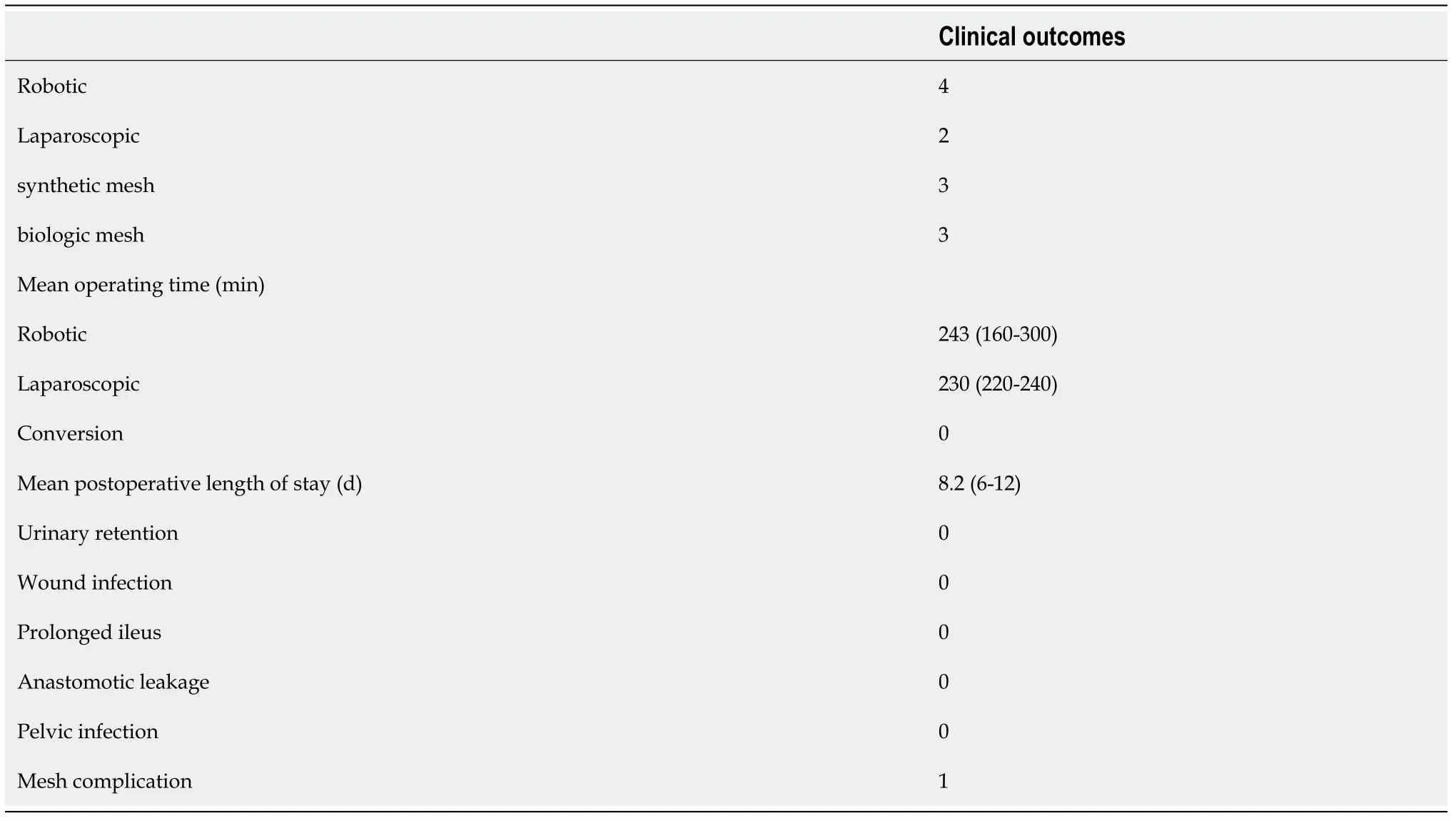
Table 2 Perioperative results
The mean Patients Assessment of Constipation Quality of Life score improved from 57.5 (range 42-69) to 23.3 (range 13-38) (P< 0.05, respectively). The score was then stable after 6 mo (Figure 4). An improvement in patient’s quality of life was observed in all four subsets (physical discomfort, psychosocial discomfort, worries and concerns, and satisfaction). All six patients were satisfied with the surgery and had no regrets regarding the surgical treatment. There was no recurrence or novel constipation after surgery. None of the patients used laxative medication.
DISCUSSION
ODS is a benign condition characterized by a multifactorial etiology that predominantly affects females and the elderly with symptoms of obstructed defecation[27,28].When treatment with medication becomes less effective, the patient has to consider surgery as quality of life is severely impaired. The goal of surgical treatment is not only to repair anatomic abnormalities, but also to restore defecation function and avoid novel symptoms. Many operative procedures have been described in the literature, but there is no one procedure that suits all patients. The decision on surgical procedure depends on the comorbidities of the patient, the patient’s age and bowel function, and the surgeon’s preference and experience[22].
The present study is the first on AVR with colectomy in selected patients with ODS,which achieved satisfactory functional results during a 3-year follow-up period,despite the small number of cases. Our results showed that all six patients showed significant improvement in constipation after surgery. Their quality of life also improved significantly, and all six patients were satisfied with the surgical treatment at each follow-up postoperatively. The scores showed the best remission and stabilization at 6 to 12 mo during long-term follow-up, which is similar to that in the other studies[29]. It is worth noting that the scores in four patients showed a slight increase after 12 mo, which implied that treatment of constipation requires a multidisciplinary approach for a long period after surgery. Although surgery corrected the abnormal anatomical structures, bowel motility function, hormone level,psychological effect, and other comprehensive factors can also affect the patient's defecation function[1]. The clinical outcomes were acceptable, although one patient developed mesh erosion. There was no pelvic infection, anastomosis leakage, or other complications in these six patients.
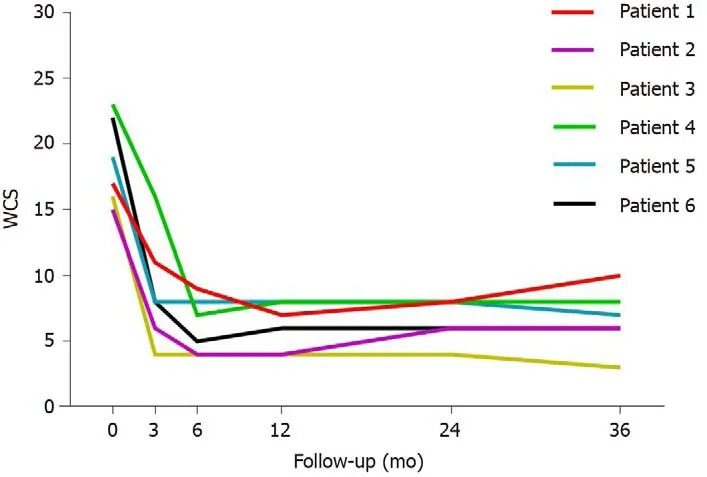
Figure 2 The variation in constipation symptoms in patients with obstructed defecation syndrome undergoing surgery assessed by a Wexner Constipation Score > 15, as severely symptomatic. The mean Wexner Constipation Score before surgery was 18.6 (range 15-23) and the scores reduced to 6.7 (range 3-10) at 36 mo. WCS: Wexner Constipation Score.
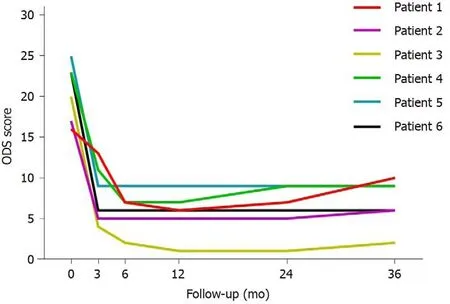
Figure 3 The variation in constipation symptoms in patients with obstructed defecation syndrome undergoing surgery assessed by an obstructed defecation syndrome score > 10, as severely symptomatic. The mean obstructed defecation syndrome score decreased from 20.7 (range 16-25) preoperatively to 7 (range 2-10) at the end of follow-up. ODS: Obstructed defecation syndrome.
LVR was initially designed for ERP, and it was later applied to the treatment of high-grade IRP accompanied by ODS[30]. The advantages of purely anterior rectal mobilization include the prevention of anterior recto-rectal intussusception and reinforcement of the rectovaginal septum, as well as avoidance of autonomic nerve injury and the risk of new-onset constipation. Many studies have shown that LVR had a lower recurrence rate and better functional improvement of OD, FI, and gastrointestinal quality of life[15,17,31-33]. Postoperative constipation after LVR may improve up to 80% in patients with mesh use over a long-term follow-up[34].Nevertheless, the functional results are still not satisfactory for patients with ODS,which is different to ERP. Due to the multifactorial etiology and a large spectrum of symptoms, patients with IRP usually have accompanying different morphological alterations of the pelvic floor, the colon and rectum. Abdominal surgery is performed to deal with the whole spectrum of underlying alterations as much as possible.
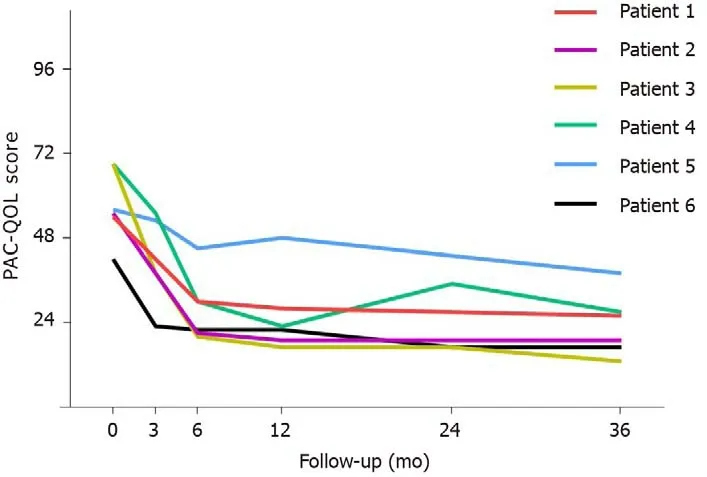
Figure 4 Quality of life assessed by the Patients Assessment of Constipation Quality of Life score in patients with obstructed defecation syndrome before and after surgery. The mean Patients Assessment of Constipation Quality of Life score improved from 57.5 (range 42-69) to 23.3 (range 13-38). PAC-QOL: Patients Assessment of Constipation Quality of Life.
According to the clinical practice guidelines of rectal prolapse, sigmoid resection may be added to posterior rectopexy in patients with prolapse and preoperative constipation[22]. LRR is a safe and effective procedure achieving greater improvement of constipation, especially in patients with a symptomatic sigmoidocele[21]. However,some studies showed that the functional results of LRR were similar to those of LVR,but postoperative complications may be increased with an additional resection[20,23,24].
The generic term ‘‘resection rectopexy’’ includes resection and rectopexy, but the extent of colonic resection, method of rectal mobilization and fixation vary considerably in historical literature. The procedure of LRR was performed by sigmoidectomy and posterior rectal suture fixation, including mobilization of the left colon with the splenic flexure unmobilized and retrorectal mobilization to the pelvic floor[35]. Therefore, different methods of rectopexy and resection might result in different functional outcomes.
In this study, we implemented VMR combined with extended resection of the sigmoid colon and descending colon based on the fact that all six patients suffered from severe constipation accompanied by a lengthy colon and pelvic floor structural abnormalities. Two patients had accompanying rectocele, and two patients had sigmoidocele. Four patients had abnormally prolonged colonic transit time, and residual markers existed in the descending colon and sigmoid colon. Interestingly, El Muhtasebet al[36]reported that the colonic transit time was not changed after resection rectopexy. This might be attributed to the potential damage of autonomic nerves due to mobilization of the posterior and lateral rectum. However, the changes in colonic transit time after AVR with colectomy are not clear, and further study is needed in these patients.
A recent review by Albayatiet al[17]showed that robotic ventral rectopexy had fewer conversions to open surgery and fewer complications, but it required a longer operative time with no added benefit over LVR. Robotic ventral rectopexy and LVR are good options for ODS associated with IRP. In the current study, the operating time between robotic- and laparoscopic-assisted procedures was slightly different.Although robotic-assisted surgery took more time in the preparation stage, it had an obvious advantage in pelvic structure dissection, especially in lower mesh suture fixation.
It was considered that synthetic mesh had a lower recurrence rate but a higher complication rate compared with biological mesh[37]. The postoperative improvement in constipation was approximately 80% in patients with biologic mesh used for a longterm follow-up, which is similar to synthetic mesh[34]. Unfortunately, one patient developed mesh erosion at 15 mo after surgery in our study. The rectum was corroded by the biologic mesh and the patient achieved complete symptomatic remission after the mesh was removed. The reason for this might be related to the mesh material or the suture technique. Although the rate of biologic mesh erosion is obviously lower than that of synthetic mesh[38,39], technical errors in dissection of the rectovaginal septum and different sized meshes may be possible causes of erosion[40]. Attention should be paid to the risk factors involved, including poor physical condition and tissue healing, uncontrolled diabetes mellitus, smoking, and previous pelvic irradiation.
Colectomy is usually not advocated in combination with repairs involving mesh.However, a strict aseptic operation, pelvic irrigation, complete coverage of the pelvic peritoneum during surgery, and the use of biological mesh can reduce the risk of potential pelvic infection and complications.
The present study has some limitations. First, this was only an observational preliminary study of several selected patients, due to the small number of cases and different heterogeneities of the patients. The safety and effectiveness need further exploration in a large number of patients. Second, there may have been some differences between the robotic and laparoscopic surgeries in the study. For example,robotic-assisted surgery requires a longer operative time with no significant benefit over laparoscopic surgery. More studies are required to clarify the potential technical advantage of robotic surgery in achieving an improvement in the clinical outcome.Third, although there are no studies comparing biological mesh with synthetic mesh in VMR, two different types of mesh were used in this study, which could have affected the clinical outcomes. Finally, a control group of AVR without colectomy is lacking in this study, which could be more powerful in proving whether extended colectomy is necessary.
CONCLUSION
The postoperative results and long-term functional outcomes are satisfactory in selected patients with ODS. Robotic and laparoscopic-assisted ventral rectopexy with colectomy is a safe and effective procedure. However, comprehensive preoperative evaluation and careful patient selection are essential.
ARTICLE HIGHLIGHTS
Research background
Abdominal ventral rectopexy (AVR) with colectomy is controversial in the treatment of obstructed defecation syndrome (ODS). Literature data on this technique are very limited.
Research motivation
ODS is the most common type of chronic constipation. In patients with severe symptoms of constipation, reduced quality of life, and conservative treatment have failed, surgery should be considered. Many different surgical procedures have been reported, but no optimal procedure has been identified for all patients to date. It is controversial whether an additional colon resection in rectopexy is required.Laparoscopic ventral rectopexy has become a salutatory procedure with better functional outcomes in recent years, and it achieved an 80% improvement in constipation. Therefore, whether AVR combined with an additional colon resection can provide better functional results in the treatment of ODS has not been reported and is worthy of exploration.
Research objectives
The research objectives were to evaluate the efficacy and safety of AVR with colectomy in selected patients with ODS. The primary objectives were improvement in functional outcomes determined by constipation symptoms and quality of life assessed by the Wexner Constipation Score, ODS score and the Patients Assessment of Constipation Quality of Life score through patient-self comparison pre- and post-operatively.Secondary objectives were operating time, postoperative length of stay, complications and mortality, improvement of pelvic floor structure, and patient satisfaction.
Research methods
Consecutive patients who received AVR with colectomy for ODS between January 2016 and December 2017 in our department were identified prospectively. Data regarding patient demographics, perioperative surgical results and postoperative follow-up outcomes were obtained prospectively. Patients with ODS who conformed to the Rome III criteria of functional constipation and who failed maximal conservative treatments including biofeedback and medical therapy were eligible. These patients had severe constipation symptoms [Wexner Constipation Score (WCS) > 15 and ODS score > 10], and high grade (III/IV) full-thickness rectal intussusception, along with pelvic floor anatomic abnormalities. All operations were performed by the same surgical team to ensure quality control (Figure 1). Statistical analyses were performed using SPSS 24.0 (SPSS, Chicago, IL, United States). The Mann–WhitneyUtest was used to compare the preoperative scores with the follow-up scores.
Research results
Perioperative outcomes: Six patients underwent robotic-assisted and laparoscopicassisted ventral mesh rectopexy with colectomy. All patients were diagnosed as having grade III and IV internal rectal prolapse along with pelvic organ prolapse, deep cul-de-sac, and redundant sigmoid colon. There was no conversion to open procedure and no postoperative mortality. No urinary retention, wound infection, prolonged ileus, pelvic infection, and anastomosis leakage occurred. One patient who developed mesh erosion into the rectum complained of pelvic pain and was examined by pelvic magnetic resonance imaging and proctoscopy at 15 mo postoperatively. The patient achieved complete symptomatic remission after the mesh was removed transanally by colonoscopy. Functional outcomes: All patients completed 36 mo follow-up after surgery. The mean WCS before surgery was 18.6 (range 15-23). The mean WCS improved to 6.7 (range 3-10) at 36 mo. Six patients showed significant improvement in constipation after surgery compared with the preoperative condition (P< 0.05). The mean ODS score decreased from 20.7 (range 16-25) preoperatively to 7 (range 2-10) at the end of follow-up (P< 0.05, respectively). The mean Patients Assessment of Constipation Quality of Life score improved from 57.5 (range 42-69) to 23.3 (range 13-38) (P< 0.05, respectively). Six patients were satisfied with the surgery and had no regrets regarding surgical treatment. There was no recurrence or novel constipation after surgery. None of the patients used laxative medication.
Research conclusions
The postoperative results and long-term functional outcomes are satisfactory for selected patients with ODS. Robotic and laparoscopic-assisted ventral rectopexy with colectomy is a safe and effective procedure. However, comprehensive preoperative evaluation and careful patient selection are essential.
Research perspectives
This was the first study to explore AVR with colectomy for the treatment of ODS. The results showed that these patients achieved satisfactory functional results during a 3-year follow-up, despite the small number of cases. Although the present study has some limitations, we will increase the number of patients and include a control group of AVR without colectomy in a subsequent study, which could be more powerful in proving whether colectomy is necessary.
杂志排行
World Journal of Clinical Cases的其它文章
- Understanding the immunopathogenesis of COVID-19: Its implication for therapeutic strategy
- What is the gut feeling telling us about physical activity in colorectal carcinogenesis?
- Latest developments in chronic intestinal pseudo-obstruction
- Correlation between ductus venosus spectrum and right ventricular diastolic function in isolated single-umbilical-artery foetus and normal foetus in third trimester
- Clinical efficacy of integral theory–guided laparoscopic integral pelvic floor/ligament repair in the treatment of internal rectal prolapse in females
- Treatment of Kümmell’s disease with sequential infusion of bone cement: A retrospective study
